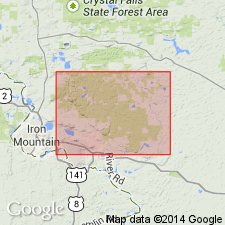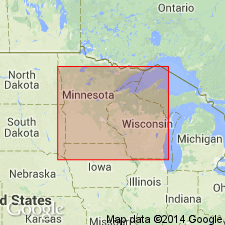
- Usage in publication:
-
- Carney Lake Gneiss*
- Modifications:
-
- Revised
- Overview
- Dominant lithology:
-
- Gneiss
- Granodiorite
- Syenite
- AAPG geologic province:
-
- Michigan basin
Summary:
Carney Lake Complex of Treves (1960) is revised as Carney Lake Gneiss. Type area designated as eastern half of T40N, R29W [in Dickinson Co., northwestern MI]. Consists of 85 percent granitic gneiss; remainder is granodiorite and syenite dikes. Gneiss is not uniform in appearance, but varies from gray plagioclase-biotite gneiss to red microcline-biotite gneiss. Contains 10 percent inclusions of amphibolite, biotite schist, and metasedimentary rocks. Rocks are overlain by middle Precambrian Sturgeon Quartzite (early Animikie age) to the south and west; to the north, the rocks are in fault contact with middle Precambrian (late Animikie) Michigamme Slate. Age is early Precambrian based on stratigraphic position and radioisotope dates ranging from 2,590 to 1,240 on several minerals (biotite, microcline, zircon); age is estimated as 2,700 m.y. as reported by Davis and others (1960).
Source: GNU records (USGS DDS-6; Reston GNULEX).

- Usage in publication:
-
- Carney Lake Gneiss*
- Modifications:
-
- Overview
- AAPG geologic province:
-
- Lake Superior region
Summary:
Is the southernmost exposed Archean unit in MI's Upper Peninsula, Dickinson Co, Lake Superior region. Strongly deformed and cataclastic gneissic rocks consisting of mostly granitic gneiss with minor interlayered hornblende-biotite gneiss and biotite-rich gneiss. Correlation chart. Is assigned a Late Archean age.
Source: GNU records (USGS DDS-6; Denver GNULEX).
For more information, please contact Nancy Stamm, Geologic Names Committee Secretary.
Asterisk (*) indicates published by U.S. Geological Survey authors.
"No current usage" (†) implies that a name has been abandoned or has fallen into disuse. Former usage and, if known, replacement name given in parentheses ( ).
Slash (/) indicates name conflicts with nomenclatural guidelines (CSN, 1933; ACSN, 1961, 1970; NACSN, 1983, 2005, 2021). May be explained within brackets ([ ]).

